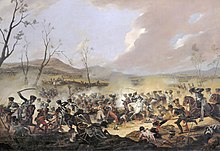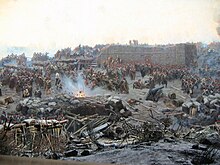Henry Hardinge, 1st Viscount Hardinge
Member of Parliament | |
|---|---|
| In office 1820–1844 | |
| Personal details | |
| Born | 30 March 1785 |
| Spouse | Lady Emily Jane Stewart |
| Children | 4 |
| Military service | |
| Allegiance | United Kingdom |
| Branch/service | British Army |
| Years of service | 1799–1856 |
| Rank | Field Marshal |
| Commands | Commander-in-Chief of the British Army |
| Battles/wars |
|
| Awards | Knight Grand Cross of the Order of the Bath |
Henry Hardinge, 1st Viscount Hardinge,
Early life
The son of the Rev, Henry Hardinge, Rector of Stanhope,[1] and his wife Frances Best, he was educated at Durham School and Sevenoaks School.[2] Hardinge entered the British Army on 23 July 1799 as an ensign in the Queen's Rangers,[3] a corps then stationed in Upper Canada.[4] He was promoted to lieutenant by purchase in the 4th Regiment of Foot on 27 March 1802[5] and transferred to the 1st Regiment of Foot on 11 July 1803[6] before becoming a captain of a company by purchase in the 57th Regiment of Foot on 21 April 1804.[7] In February 1806 he was sent to the newly formed Staff College at High Wycombe.[8]
Military career
Peninsular War

He saw action at the
Hundred Days campaign
When war broke out again in 1815 after Napoleon's escape from Elba, Hardinge returned to active service as a brigadier.[4] Attached to the staff of the allied Prussian Army under Marshal Blucher, he was present at the Battle of Ligny on 16 June 1815, where he lost his left hand by a shot, and thus was not present at Waterloo two days later.[4][12] Wellington presented him with a sword that had belonged to Napoleon.[4] Hardinge remained attached to the Prussian army of occupation in France until 1818.[12]
He was promoted to brevet
Political service
Member of Parliament

At the 1820 general election, Hardinge was returned to parliament as member for
In July 1830 he exchanged portfolios with
Chief Secretary for Ireland
He was appointed Chief Secretary for Ireland from December 1834 to April 1835, and then was Secretary at War once again in Sir
Governor-General of India
In May 1844 he succeeded
| Viscount Hardinge's Annuity Act 1846 | |
|---|---|
| Act of Parliament | |
 9 & 10 Vict. c. 21 | |
| Dates | |
| Royal assent | 18 June 1846 |
| Other legislation | |
| Repealed by | Statute Law Revision Act 1875 |
Status: Repealed | |
| Annuity Lord Hardinge Act 1846 | |
|---|---|
| Act of Parliament | |
 9 & 10 Vict. c. 31 | |
| Dates | |
| Royal assent | 27 July 1846 |
| Other legislation | |
| Repealed by | Statute Law Revision Act 1953 |
Status: Repealed | |
Recognising an annuity of £5,000 being paid by the East India Company, Parliament provided that Viscount Hardinge should continue to receive his full salary as Governor General.[26] Under a subsequent Act, in recognition of his "great and brilliant services", Parliament settled an annuity of £3,000 on Lord Hardinge and the next two heirs male of his body, although this was not to be paid if the East India Company paid an annuity.[27]
Commander-in-Chief

Hardinge returned to England in 1848, and became
He was also colonel of the 97th Regiment of Foot from 4 March 1833[33] and of the 57th Regiment of Foot from 31 May 1843.[34]

Hardinge resigned his office of commander-in-chief in July 1856, owing to failing health, and died on 24 September 1856 at South Park near Tunbridge Wells.[4] There is a memorial to him at St John the Baptist, Penshurst.[35] He is buried in the churchyard at St. Peter, Fordcombe.[36]
Family
In 1821 he married Lady Emily Jane, seventh daughter of Robert Stewart, 1st Marquess of Londonderry.[4] They had two sons, and two daughters:
- Charles Stewart Hardinge, 2nd Viscount Hardinge of Lahore and Kings Newton (2 Sep 1822 – 28 July 1894)
- Arthur Edward Hardinge (2 Mar 1828 – 15 July 1892) married Mary Georgina Frances Ellis, daughter of Lt.-Col. Hon. Augustus Frederick Ellis. They had two sons, and three daughters, one of whom being Arthur Henry Hardinge.
- Hon. Frances Elizabeth Hardinge (d. 9 July 1894) married Gen. Sir Arthur Cunynghame, son of Sir David Cunynghame, 5th Baronet. They had two sons, and three daughters.
- Hon. Emily Caroline Hardinge (d. 4 Sep 1876). Unmarried, a lady-in-waiting to Princess Alice of the United Kingdom.[37]
His elder son, Charles Stewart, who had been his private secretary in India, was the 2nd Viscount Hardinge. The younger son of the 2nd Viscount, Charles Hardinge (b. 1858), became a prominent diplomat, and was appointed Viceroy of India in 1910, being created Baron Hardinge of Penshurst.[38]
References
- ^ "No. 12833". The London Gazette. 24 February 1787. p. 101.
- ^ "Henry Hardinge". Sevenoaks School. Retrieved 3 January 2020.
- ^ "No. 15161". The London Gazette. 20 July 1799. p. 730.
- ^ doi:10.1093/ref:odnb/12271. (Subscription or UK public library membershiprequired.)
- ^ "No. 15464". The London Gazette. 23 March 1802. p. 304.
- ^ "No. 15600". The London Gazette. 9 July 1803. p. 831.
- ^ "No. 15694". The London Gazette. 17 April 1804. p. 475.
- ^ a b c Heathcote, p.171
- ^ "No. 16887". The London Gazette. 19 April 1814. p. 836.
- ^ "No. 16934". The London Gazette. 13 September 1814. p. 1850.
- ^ "No. 16934". The London Gazette. 13 September 1814. p. 1852.
- ^ a b "Hardinge, Sir Henry". History of Parliament. Retrieved 19 January 2016.
- ^ "No. 17727". The London Gazette. 20 July 1821. p. 1510.
- ^ "No. 18709". The London Gazette. 23 July 1830. p. 1535.
- ^ "No. 17911". The London Gazette. 5 April 1823. p. 541.
- ^ a b c d "HARDINGE, Sir Henry (1785–1856), of Ketton, co. Dur. and 16 Sackville Street, Mdx". History of Parliament Online.
- ^ "No. 18477". The London Gazette. 10 June 1828. p. 1118.
- ^ "No. 20015". The London Gazette. 7 September 1841. p. 2247.
- ^ Cox, Montagu H and Norman, Philip. "No. 3 Whitehall Gardens Pages 204–207 Survey of London: Volume 13, St Margaret, Westminster, Part II: Whitehall I. Originally published by London County Council, London, 1930". British History Online. Retrieved 7 August 2020.
{{cite web}}: CS1 maint: multiple names: authors list (link) - ^ "No. 20346". The London Gazette. 24 May 1844. p. 1762.
- ^ "No. 20363". The London Gazette. 12 July 1844. p. 2418.
- ^ "No. 20576". The London Gazette. 23 February 1846. p. 721.
- ^ "No. 20602". The London Gazette. 8 May 1846. p. 1678.
- ^ "No. 20602". The London Gazette. 8 May 1846. p. 1681.
- ^ "No. 20592". The London Gazette. 7 April 1846. p. 1278.
- 9 & 10 Vict.c. 21)
- 9 & 10 Vict.c. 31)
- ^ "No. 21299". The London Gazette. 9 March 1852. p. 741.
- ^ "No. 21362". The London Gazette. 28 September 1852. p. 2573.
- ^ "No. 21564". The London Gazette. 22 June 1854. p. 1931.
- ^ "No. 21792". The London Gazette. 2 October 1855. p. 3652.
- ISBN 0-7195-5756-9Weintraub, p.334
- ^ "No. 19028". The London Gazette. 8 March 1833. p. 474.
- ^ Heathcote, p.172
- ^ "Church of St John the Baptist, Penshurst". British listed buildings. Retrieved 22 July 2015.
- ^ "Fordcombe" (PDF). Kent Fallen. Retrieved 6 February 2019.
- ^ "Princess Alice of Hesse". The Knickerbocker Press. Retrieved 4 December 2022.
- ^ "Charles Hardinge, 1st Baron Hardinge of Penshurst". Cracrofts Peerage. Archived from the original on 17 June 2012. Retrieved 3 March 2012.
Bibliography
- Hardinge, Charles (1891). Viscount Hardinge. Forgotten Books. ASIN B008VNGNS6.
- Heathcote, Tony (1999). The British Field Marshals 1736–1997. Pen & Sword Books Ltd. ISBN 0-85052-696-5.
- Rait, Robert (1903). Life and Campaigns of Viscount Gough. Forgotten Books. ASIN B008ROL9TC.

